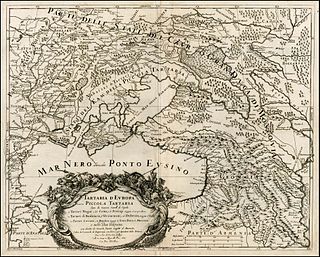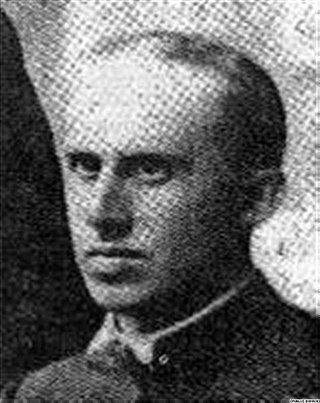
Sloboda Ukraine, also known locally as Slobozhanshchyna, is a historical region in northeastern Ukraine and southwestern Russia. It developed and flourished in the 17th and 18th centuries on the southwestern frontier of the Tsardom of Russia. In 1765, it was converted into the Sloboda Ukraine Governorate.

The Directorate, or Directory was a provisional collegiate revolutionary state committee of the Ukrainian People's Republic, initially formed on 13–14 November 1918 during a session of the Ukrainian National Union in rebellion against the Ukrainian State. During the Anti-Hetman Uprising it was named as the Executive Council of the State Affairs. Its authority was extended by the Labor Congress of Ukraine on 23–28 January 1919.

The earliest known usage of the name Ukraine appears in the Hypatian Codex of c. 1425 under the year 1187 in reference to a part of the territory of Kievan Rus'. The use of "the Ukraine" is officially deprecated by the Ukrainian government and many English language media publications.

The Principality of Halych, or Principality of Halychian Rus', was a medieval East Slavic principality, and one of the main regional states within the political scope of Kievan Rus', established by members of the oldest line of Yaroslav the Wise descendants. A characteristic feature of the Halych principality was the important role of the nobility and citizens in political life, and consideration a will which was the main condition for the princely rule. Halych as the capital mentioned in around 1124 as a seat of Ivan Vasylkovych the grandson of Rostislav of Tmutarakan. According to Mykhailo Hrushevsky the realm of Halych was passed to Rostyslav upon the death of his father Vladimir Yaroslavich, but he was banished out of it later by his uncle to Tmutarakan. The realm was then passed to Yaropolk Izyaslavich who was a son of the ruling Grand Prince Iziaslav I of Kiev.

Bobrynets is a city in Kropyvnytskyi Raion, Kirovohrad Oblast, Ukraine. It hosts the administration of Bobrynets urban hromada, one of the hromadas of Ukraine. Population: 10,396.
The Ukrainian orthography is the orthography for the Ukrainian language, a system of generally accepted rules that determine the ways of transmitting speech in writing.
Viktor Sviatoslavovych Idzio is a Ukrainian historian and director of the Institute for Eastern Europe. Idzio was born in Ivano-Frankivsk on November 26, 1960.

The I.I. Schmalhausen Institute of Zoology of National Academy of Sciences of Ukraine is the leading institution in Ukraine doing research in zoology. At present, this is the leading regional center of zoological research and expertise in the Eastern Europe.

Volodymyr Potulnytskyi is a Ukrainian historian who specializes in European medieval history, Ukrainian political science, intellectual history, historiosophy and historiography of Eastern Europe.
Yaryzhka or Orthography of Slobozhanshchyna is the name of the Russian pre-revolutionary orthography used to write and print works in the Ukrainian language in the Russian Empire. Yaryzhka included all the letters that were part of the Russian Cyrillic alphabet of the pre-revolutionary period: ы, ъ, and so on.
Arts of Ukraine is a collection of all works of art created during the entire history of Ukraine's development.
The History of Ukrainian literature includes laws of the historical and literary process, literary genres, trends, works of individual writers, features of their style, and the importance of artistic heritage in the development of Ukrainian literature.
Shashkevychivka, Spelling of the Mermaid of the Dniester, and also Spelling of the Ruthenian Triad is the first phonetic spelling system for the Ukrainian language based on the adapted Cyrillic script, used by the Ruthenian Triad in the almanac "Mermaid of the Dniester" (1837). Markiian Shashkevych used to be considered the author of the spelling system used in "Mermaid of the Dniester", which is why it is called Orthography of Shashkevych or Shashkevychivka. The use of the phonetic principle of spelling was motivated in the foreword by Markiian Shashkevych by the fact that «we need to know what the true face is in the present language; because of this we follow the rule: „write as you hear, and read as you see“».

Orthography of Smal-Stotskyi and Gartner, also Orthography of Smal-Stotskyi and ScientificOrthography is a Ukrainian orthography created on the basis of Zhelekhivka by Stepan Smal-Stotskyi in collaboration with Theodor Gartner. One of the main innovations of spelling was that the authors also adapted Zhelekhivka for foreign words. In 1891, under the pseudonym Stepan Nahnybida, Smal-Stotskyi published a description of his spelling principles in a 16-page pamphlet On Ruthenian Orthography. In 1893, Smal-Stotskyi and Gartner published the Ruthenian Grammar, which listed all the phonetic rules of this spelling in practice.

The Lithuanian-Muscovite War of 1487–1494 was the war of the Principality of Moscow, in alliance with the Crimean Khanate, against the Grand Duchy of Lithuania in alliance with the Golden Horde Khan Akhmat, united by personal union. Kingdom of Poland under the leadership of Grand Duke Casimir IV Jagiellon.

Andriy Mykhailovych Bandera was a Ukrainian chaplain and politician. He was member of the Ukrainian National Rada of the Western Ukrainian People's Republic, veteran of the Polish-Ukrainian war, member of the Shevchenko Scientific Society, a priest of the Ukrainian Greek Catholic Church, and father of Stepan Bandera.
The Battle of Ozerna or Battle of Jezierna was fought on 20–22 November 1655 near Ozerna between the forces of the Polish-Tatar coalition and Ukrainian-Russian troops. The battle ended with a success for the Polish–Lithuanian Commonwealth. As a result of the Polish Lithuanian victory, Bohdan Khmelnytsky was forced to recognize the formal suzerainty of the Polish-Lithuanian Commonwealth over Russia.
Mykhailo Svitenkyi was a Ukrainian priest and public figure.
Ivan Yosyfovych Popel was a Ukrainian Greek Catholic priest, social and cultural activist. He was the uncle of Mariyka Pidhiryanka.
Ivan Kuziv was a Ukrainian Greek Catholic priest and ethnographer.









